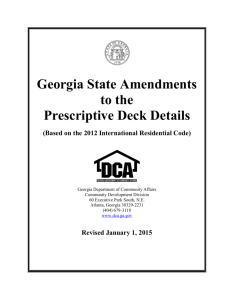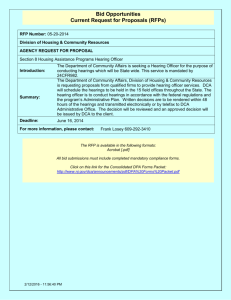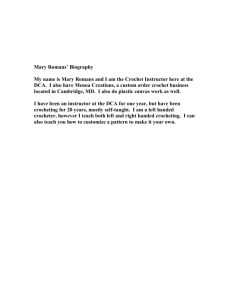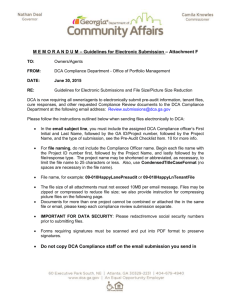2009 IRC John “Buddy” Showalter, P.E.
advertisement
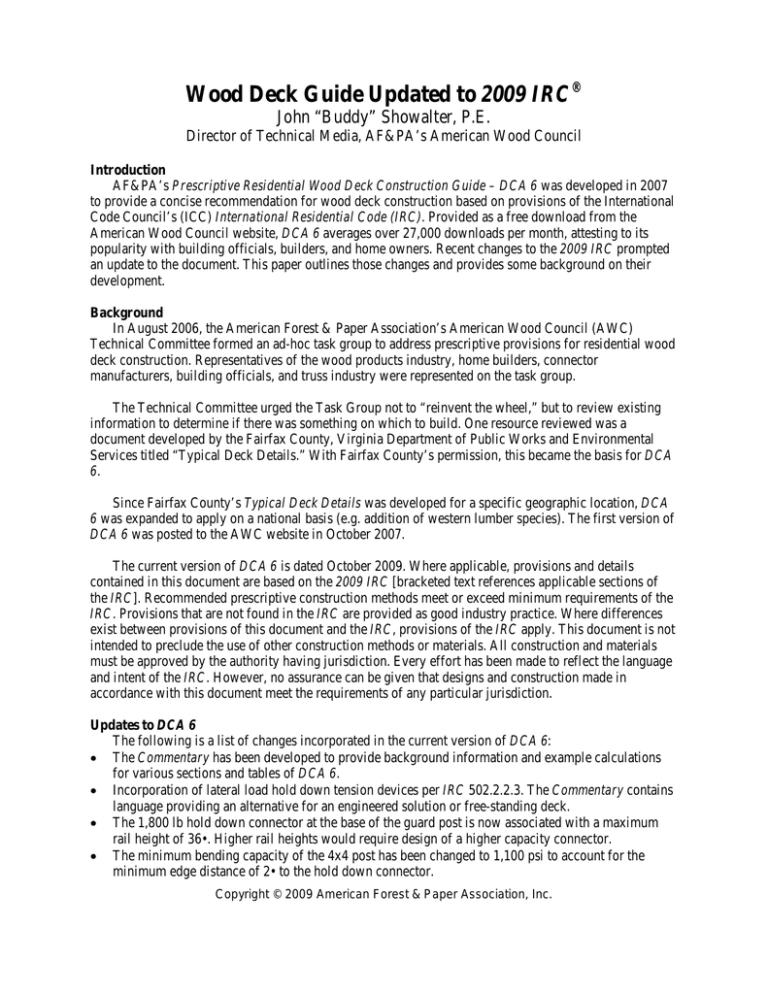
Wood Deck Guide Updated to 2009 IRC® John “Buddy” Showalter, P.E. Director of Technical Media, AF&PA’s American Wood Council Introduction AF&PA’s Prescriptive Residential Wood Deck Construction Guide – DCA 6 was developed in 2007 to provide a concise recommendation for wood deck construction based on provisions of the International Code Council’s (ICC) International Residential Code (IRC). Provided as a free download from the American Wood Council website, DCA 6 averages over 27,000 downloads per month, attesting to its popularity with building officials, builders, and home owners. Recent changes to the 2009 IRC prompted an update to the document. This paper outlines those changes and provides some background on their development. Background In August 2006, the American Forest & Paper Association’s American Wood Council (AWC) Technical Committee formed an ad-hoc task group to address prescriptive provisions for residential wood deck construction. Representatives of the wood products industry, home builders, connector manufacturers, building officials, and truss industry were represented on the task group. The Technical Committee urged the Task Group not to “reinvent the wheel,” but to review existing information to determine if there was something on which to build. One resource reviewed was a document developed by the Fairfax County, Virginia Department of Public Works and Environmental Services titled “Typical Deck Details.” With Fairfax County’s permission, this became the basis for DCA 6. Since Fairfax County’s Typical Deck Details was developed for a specific geographic location, DCA 6 was expanded to apply on a national basis (e.g. addition of western lumber species). The first version of DCA 6 was posted to the AWC website in October 2007. The current version of DCA 6 is dated October 2009. Where applicable, provisions and details contained in this document are based on the 2009 IRC [bracketed text references applicable sections of the IRC]. Recommended prescriptive construction methods meet or exceed minimum requirements of the IRC. Provisions that are not found in the IRC are provided as good industry practice. Where differences exist between provisions of this document and the IRC, provisions of the IRC apply. This document is not intended to preclude the use of other construction methods or materials. All construction and materials must be approved by the authority having jurisdiction. Every effort has been made to reflect the language and intent of the IRC. However, no assurance can be given that designs and construction made in accordance with this document meet the requirements of any particular jurisdiction. Updates to DCA 6 The following is a list of changes incorporated in the current version of DCA 6: • The Commentary has been developed to provide background information and example calculations for various sections and tables of DCA 6. • Incorporation of lateral load hold down tension devices per IRC 502.2.2.3. The Commentary contains language providing an alternative for an engineered solution or free-standing deck. • The 1,800 lb hold down connector at the base of the guard post is now associated with a maximum rail height of 36•. Higher rail heights would require design of a higher capacity connector. • The minimum bending capacity of the 4x4 post has been changed to 1,100 psi to account for the minimum edge distance of 2• to the hold down connector. Copyright © 2009 American Forest & Paper Association, Inc. Wood Deck Guide Updated • • • • • • • • • • • • • • Page 2 A 1.6 load duration factor for guard post design is used to be consistent with hold down capacity requirements. As a result of this change, #2 grade 4x4 posts calculate for all species. Removed requirements for knee braces parallel to the beam adjacent to the house for a free standing deck. Specification of a load capacity of 625 pounds for the stair stringer joist hanger. Reference to threaded nails versus common nails. Modified fastener requirements for 2x8 ledger to 2x8 band joist connections. Added capacity requirements for trimmer joist hangers and require trimmer hanger fasteners to extend fully into the band joist or rim board to avoid a high concentrated load on the ledger. Revised the stair footing detail to show a bearing block. Revised the flashing detail to alleviate the need for notched flashing around joists. Added spans for joists without overhangs to Table 2 based on user requests. Added square footing dimensions to Table 4 based on user requests. Under footings, added the sentence: “Contact the authority having jurisdiction to determine the specified frost line.” Under footings, added “call 811” to contact utilities since this is now a nationwide program. Added square footing dimensions to DCA 6 and the comparable Commentary table. Included safety glazing requirements in the Commentary Appendix. Additional background is provided as follows on some of the more notable revisions listed above: DCA 6 Commentary The DCA 6 Commentary is integrated with and follows the same organizational structure as DCA 6. Discussion of a particular provision is found in the DCA 6 Commentary by locating the same section or subsection found in DCA 6. Not every section of DCA 6 has a corresponding commentary section. The DCA 6 Commentary provides background information intended to give the reader an understanding of the data and/or experience on which the provision is based. One or more examples of the calculation procedures used to produce several of the tables are given to illustrate the scope of conditions covered by the tables. The provisions of DCA 6 come primarily from the IRC. In developing the DCA 6 Commentary, data available from laboratory tests and experience with structures in-service was analyzed and evaluated for the purpose of providing a consistent explanation. It is intended that this document be used in conjunction with competent design, accurate fabrication, and adequate supervision of construction. Lateral Hold Down Connector to the House IRC R502.2.2 states, "Decks. Where supported by attachment to an exterior wall, decks shall be positively anchored to the primary structure and designed for both vertical and lateral loads as applicable." There's a new provision in the 2009 IRC as follows: R502.2.2.3 Deck lateral load connection. The lateral load connection required by Section R502.2.2 shall be permitted to be in accordance with Figure R502.2.3. Hold-down tension devices shall be provided in not less than two locations per deck, and each device shall have an allowable stress design capacity of not less than 1500 lb. The IRC includes hold down tension devices as a prescriptive means to achieve compliance with the lateral load connection requirements without requiring engineering. Figure R502.2.3 (DCA 6 Figure 23A) was taken directly from the FEMA Home Builder's Guide to Seismic Resistant Construction (FEMA 232) which refers to it as an “above-code recommendation.” In lieu of the prescriptive hold down tension Copyright © 2009 American Forest & Paper Association, Inc. Wood Deck Guide Updated Page 3 device specified, an alternate engineered connection detail is permitted or the deck can be designed to be free-standing. While Item 7 of DCA 6 Minimum Requirements states that the document does not address wind or seismic design issues, some interpret IRC R502.2.2 to be applicable in all cases since lateral loads can be developed by other sources including people moving or dancing on a deck. Another interpretation is that the term “as applicable” in R502.2.2 means the provision is only required for code prescribed loads. The only code prescribed lateral loads are wind and seismic. Guard Post Hold Down Connector Both the IRC and International Building Code (IBC) specify that guardrails and handrails be capable of resisting a minimum concentrated live load of 200 lbs applied in any direction. A minimum requirement of 1,800 lbs for the hold down connector at the base of the guard post ensures adequate capacity (Loferski et al., 2005) for a 36" maximum rail height. A higher rail height requires design of a higher capacity connector. Manufacturers’ tabulated values for hold down connectors typically include a load duration (CD) increase of 60% since connectors for shear walls are used to resist wind and seismic loads. The 200 lbs concentrated load requirement for guard rails is assumed to be a 10 minute load duration (e.g. it would not see a maximum 200 lbs outward load for more than 10 minutes cumulatively in its lifetime). Therefore, CD=1.6 is used for hold downs in this application. Guard Post Capacity Deck guard posts must be at least 4x4 nominal with a reference bending design value not less than 1,100 psi to ensure sufficient bending strength in the post. The lever arm to determine this requirement is assumed to be 39.5" (36" + 1.5" deck board + 2" edge distance). No. 2 grades of all DCA 6 Table 2 species meet this requirement with the following assumptions. The adjusted bending design value, F'b, is based on a wet service factor, CM = 0.85, and incising factor, Ci = 0.80 (Douglas fir-larch, hem-fir, spruce-pine-fir). A load duration factor, CD = 1.6, is assumed for consistency with the hold down device used to connect the guard to the joist. Requirements for Knee Braces DCA 6 states: “Decks attached to the house as shown in Figure 23A do not require diagonal bracing perpendicular to the house.” Since the hold down tension device will resist lateral loads perpendicular to the house, knee braces are not required in that direction. DCA 6 further specifies: “Diagonal bracing parallel to the house may be omitted at the beam adjacent to the house for a free-standing deck attached as shown in Figure 23.” This prescriptive detail only applies to a self-supporting deck. The intent here is to keep the deck from impacting the house if the deck isn’t stiff enough to prevent some lateral deflection perpendicular to the house. In the parallel direction, any lateral loads will be resisted by the fasteners attaching the ledger to the house studs. Therefore, knee braces are not necessary in this direction since lateral support will be within L/4 of the beam. Stair Stringer Joist Hanger The joist hanger gravity load capacity requirements listed in DCA 6 Table 3A are derived from worst case reactions calculated from Table 2. The Stair Requirements section states that “all stringers shall be a minimum of 2x12,” requiring an 800 lb minimum joist hanger gravity load capacity per Table 3A. Span and spacing limitations of cut and solid stringers are clearly outlined in the Stair Requirements section, and Figures 28 and 29. For either stringer type, 18• is the maximum tributary area. The maximum span is 16′ 6•. The maximum stringer reaction is then calculated as 618 lbs. DCA 6 Figure 31 was therefore revised to reflect a minimum hanger gravity load capacity of 625 lbs. Copyright © 2009 American Forest & Paper Association, Inc. Wood Deck Guide Updated Page 4 Threaded Nails Smooth shank nails are prone to “backing out” of wood due to moisture cycling. Threaded nails include helical (spiral) and annular (ring-shank) nails as defineded in ASTM F 547. Including the common terms “spiral” and “ring-shank” is important to ensure availability from lumber yards. Reference design values for post frame ring shank nails in accordance with ASTM F1667 are provided in DA4: Post Frame Ring Shank Nails (AF&PA 2007). Tabulated values are calculated in accordance with the 2005 National Design Specification® (NDS®) for Wood Construction yield limit equations. 2x8 Ledger to 2x8 Band Joist Connections The requirement for minimum distance, de, between the top of the ledger and the bottom row of fasteners (DCA 6 Figure 19) is based on NDS 3.4.3.3(a) for shear design at connections. When the connection is less than five times the depth, 5d, of the bending member from its end, the values of de are as follows: 2x8 2x10 2x12 ½" bolts de = 5.47" de = 6.43" de = 7.33" ½" lags de = 4.43" de = 5.21" de = 5.9" The problem with these effective depths is that a 2x8 ledger connected to a 2x8 band joist with bolts will not work (see DCA 6 Figure C19). DCA 6 Figure C19. Edge Distance and Spacing Requirements for 2x8 Band Joist and 2x8 Ledger. As noted in the Commentary, there are several options to address this issue: 1) Free standing deck. 2) Step-down the deck 7-¾" from the threshold per IRC requirements and connect to the wall below. Note that this solution is prohibited if the wall is for a walk-out basement. 3) Require lag screws for 2x8 band joist and revise required de = 4.5" as shown in Figure 19. 4) Allow bolted connections for 2x8 band joist if bolt spacing is reduced to the same as that for lag screws (only applies to ½" bolts without stacked washers as shown in DCA 6 Table C5) as shown in Figure 19. 5) Reduce bolt spacing requirements for 2x8 ledger to 2x8 band joist. This results in revised spacing for ½" bolts as shown in Table C5. Copyright © 2009 American Forest & Paper Association, Inc. Wood Deck Guide Updated Page 5 DCA 6 Table C5. Revised Bolt Spacing Requirements for 2x8 Ledgers to 2x8 Band Joists. 6'-0" & less ½" bolt ½" bolt with ½" stacked washers Joist Span 6'-1" to 8'-1" to 10'-1" to 8'-0" 10'-0" 12'-0" 32" 24" 19" 16" 27" 20" 16" 13" Trimmer Joists Where the header frames into the trimmer joist, a concentrated load is created. This condition was evaluated assuming one ply of a double trimmer joist carries the uniform load and one ply carries the point load from a 6' header. The analysis revealed that the distance from the end of the trimmer joist to the point where the header frames into it – designated as dimension “a” – must be limited. The maximum distance was calculated based on joist spans given in DCA 6 Table 2. A maximum distance of a = 3' was chosen to cover common framing conditions. Triple trimmer joists are required on each side of the header if joist spacing is 12" or 16" o.c., or if the trimmer joist span exceeds 8'-6"; otherwise a double trimmer joist is permitted. Bolts or lag screws used to attach the trimmer hanger to the ledger are required to fully extend through the ledger into the band joist or rim board. If a typical face mounted hanger is installed where only nails are used to attach the hanger to the ledger, the ledger would carry a large portion of the load. Since a concentrated load would be created on the ledger, it would be resisted by the bolts at the end of the ledger. As discussed under Ledger Attachment Requirements, the provisions for minimum distance, de, between the top of the ledger and the bottom row of fasteners (DCA 6 Figure 19) is based on NDS 3.4.3.3(a) for shear design at connections. Based on this analysis, trimmer joist lengths would need to be limited to the maximum trimmer joist spans shown in Commentary Table C7b, regardless of the trimmer joist species or number of plies. Since this analysis is based on a simple span trimmer joist, a trimmer joist with an overhang of up to LJ/4 would be conservative. The load on the end of the cantilever would reduce the reaction at the ledger. Stair Footings Stair stringers should be supported by bearing at the end where the stairway meets grade. While bolts are sometimes used for this detail, proximity to the end of the stringer could lead to splitting of the stringer – especially cut stringers. The 2x4 bearing block alleviates this situation. However, in addition to the bearing block, bolts would also be required to provide lateral support if a guard post is used. Flashing A new detail was added showing continuous flashing in DCA 6 Figure 14 to prevent water intrusion behind the ledger. One alternative to this detail would be continuous flashing with a drip edge, however, this would be labor intensive because the flashing would require notching at every deck joist location. Conclusion AF&PA’s Prescriptive Residential Wood Deck Construction Guide – DCA 6 was recently updated based in part on changes to the 2009 IRC. Two major developments consist of inclusion of the Commentary to provide background information and example calculations for various sections and tables of DCA 6 and incorporation of lateral load hold down tension devices per the IRC. These issues, and other Copyright © 2009 American Forest & Paper Association, Inc. Wood Deck Guide Updated Page 6 changes discussed in this paper, have enhanced DCA 6 and brought it into compliance with current codes. To download a copy of DCA 6, visit www.awc.org. References American Lumber Standard Committee (ALSC) Policy for Evaluation of Recommended Spans for Span Rated Decking Products (November 5, 2004). Germantown, MD. 2004. American Forest & Paper Association. DA4: Post Frame Ring Shank Nails. Washington, DC. 2007. American Forest & Paper Association. DCA 6 – Prescriptive Residential Wood Deck Construction Guide with Commentary. Washington, DC. 2009. American Forest & Paper Association. National Design Specification (NDS) for Wood Construction, ANSI/AF&PA NDS-2005. Washington, DC. 2005. American Wood Protection Association (AWPA). AWPA Book of Standards. Birmingham, AL. 2008. ASTM. ASTM F547 - 06 Standard Terminology of Nails for Use with Wood and Wood-Base Materials. West Conshohocken, PA. 2006. ASTM. ASTM D2555 - 06 Standard Practice for Establishing Clear Wood Strength Values. West Conshohocken, PA. 2006. ASTM. ASTM D245 – 06 Standard Practice for Establishing Structural Grades and Related Allowable Properties for Visually Graded Lumber. West Conshohocken, PA. 2006. Carradine, D. M., Donald Bender, Joseph R. Loferski, and Frank E. Woeste. “Residential Deck Ledger Connection Testing and Design.” Wood Design Focus. Vol. 16, No. 2. Forest Products Society. Madison, WI. Summer 2006. International Code Council Evaluation Service. Acceptance Criteria for Deck Board Span Ratings and Guardrail Systems (Guards and Handrails) - AC174. Washington, DC. Approved February 2007, Effective March 1, 2007. International Code Council. International Building Code, 2009 Edition. Washington, DC. 2009. International Code Council. International Residential Code, 2009 Edition. Washington, DC. 2009. Loferski, Joseph R., Dustin Albright, and Frank E. Woeste. “Tested Guardrail Post Connections for Residential Decks.” Wood Design Focus. Vol. 16, No. 2. Forest Products Society. Madison, WI. Summer 2006. Loferski, Joseph R. and Frank E. Woeste. “Strong Rail-Post Connections for Wooden Decks.” Journal of Light Construction. Williston, VT. February 2005. Copyright © 2009 American Forest & Paper Association, Inc.
